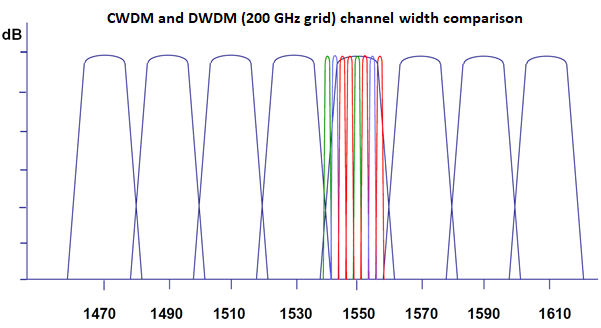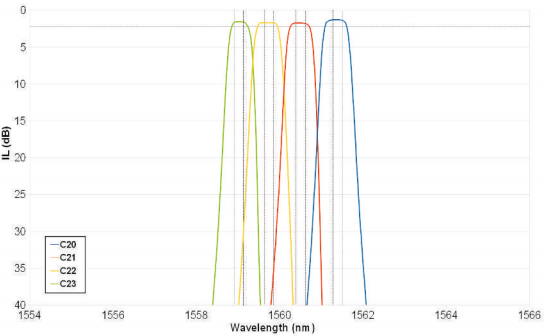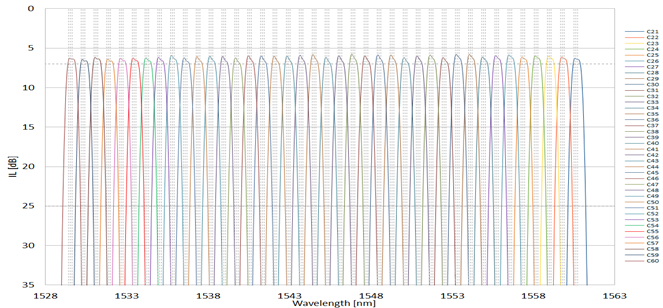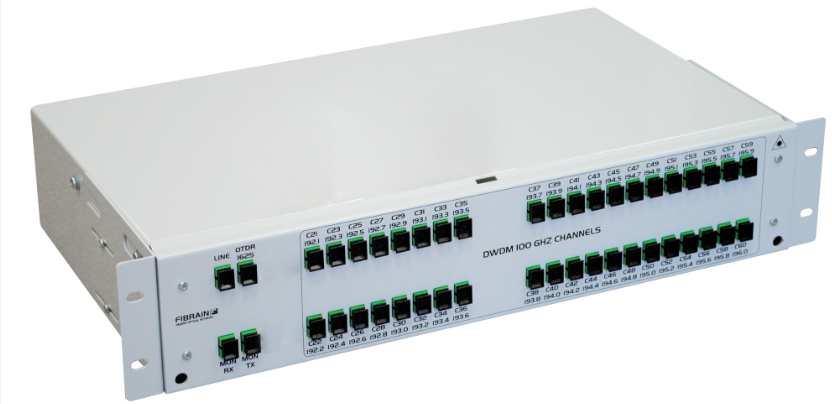Dense Wavelength Division Multiplexing is a method of increasing the link capacity with the largest functional and transmission possibilities. The basic requirements for DWDM transmission (such as number of channels, channel separation, nominal central channel frequencies, etc.) have been defined in the ITU-T G.694.1 recommendation. This recommendation defines DWDM channel grids with 12.5 GHz do 100 GHz or larger channel separation. Today, most commonly used DWDM grids are 50 GHz and 100 GHz. Comparing to CWDM transmission, the channel isolation in the DWDM method is lower by two orders of magnitude and more channels are available – usually about 40 channels for the 100 GHz grid (twice the number of channels when using the 50 GHz grid). Almost always in DWDM transmission, the so-called C-band, or 1525 – 1560 nm wavelength range, is used. Comparing to the wavelength range used in the CWDM method (i.e. 1270-1610 nm), the spectral range of DWDM system operation is much narrower, which together with a larger number of channels means that the exploitation of the available spectrum is much more efficient.

Due to transmitting the signal only around 1550 nm, losses in the optical fiber seen by each channel are practically identical (it can be different when using CWDM transmission). Available EDFA optical amplifiers allow to significantly increase ranges (CWDM link lengths are usually limited by power budget, DWM links are usually limited by OSNR budget). Chromatic dispersion is also similar for all channels, which allows its compensation if needed.
Like in CWDM systems, DWDM transport networks can be constructed as active or passive. The name “active DWDM solutions” means systems with dedicated 1st-layer transport platforms, or active devices (mainly transponders) responsible for signal transmission. Active DWDM solutions are applied in most extensive skeleton networks because they assure built-in functionalities of regeneration, monitoring, whole network management, provisioning, and signal demarcation. Fibrain also offers active DWDM solutions, which can be found in the “Active devices” category.
The biggest disadvantage of active DWDM solutions is of course their cost. The main cost component are the transponders. Their share in the cost of the whole system differs depending on the functionalities, but in simple networks it usually exceeds 70%. Therefore, many operators decide to build DWDM networks without transponders, or so-called “passive DWDM solutions”. This applies mostly to small and middle-sized operators, from whose point of view additional costs generated by the purchase of transponders are not countered by their advantages and functionality. The name “passive DWDM solutions” is not fully exact because optical amplifiers (usually of the EDFA, Erbium Doped Fiber Amplifier, type) are often used in such networks. These amplifiers are of course active devices. The cost of passive DWDM solutions is significantly lower than when using a full classical transport platform. The range of such links designed and delivered by Fibrain can be comparable to ranges in active DWDM networks, because, as it was mentioned, active optical amplifiers can still be used in passive DWDM solutions. The noise produced by the amplifiers, which degrades the signal quality, can be reduced by using unique OTN quasi-transponders produced by Menara Networks. Due to the implementation of FEC correction coding (so-called GFEC and EFEC), they have the same power budget as classical OTN transponders. Chromatic dispersion can be compensated in a similar way. There are no obstacles to construct e.g. 1000-km long 10G links using passive DWDM solutions offered by Fibrain. But, in fact, the largest advantage of our solutions is their flexibility and cost effectiveness. We are able to design and deliver both e.g. a system for point-to-point transportation of 4 DWDM channels for 100 km and a link with many OADM nodes (add/drop) for 80 channel CWDM transmission for 1000 km.
A passive DWDM transmission system contains a few components:
- optical modules (transceivers) i.e. SFP, SFP+, XFP, Xenpak, X2, etc., compliant with requirements for lasers applied in DWDM networks. Fibrain offers both standard modules with DWDM optics of all standards and unique XFP, SFP+, and Xenpak modules with built-in framing chip and FEC coder (so-called OTN quasi-transponders) produced by Menara Networks (ensuring a higher power budget and most importantly larger OSNR budget).

- passive filters and DWDM multiplexers, used in terminals and add/drop nodes for connecting (multiplexers), division (demultiplexers) and separation of selected DWDM channels from the optical multiplex (add/drop filters).
- dispersion compensating modules (DCMs), typically used in links transmitting 10G and faster signals. Chromatic dispersion is a property of optical fiber that strongly degrades the transmission quality of 10G and faster signals, and the amount of cumulated chromatic dispersion depends on the link length.

- optical amplifiers. Usually EDFA, although Fibrain offers also less common Raman amplifiers and ROPAs (remote optically pumped amplifiers) used for increasing the effective power budget and the maximal link length. Fibrain offers both single-channel and multi-channel DWDM (with a GFF - gain flattening filter) amplifiers. We also offer unique bidirectional EDFAs, which allow a bidirectional DWDM transmission with an optical gain in one fiber. A disadvantage of optical amplifiers, especially cascaded, is a phenomenon of increasing the amount of optical noise in a link, which degrades the signal quality (by lowering the OSNR – signal to noise ratio). This may require transceivers with built-in FEC correction coding.
- other special components, e.g. circulators, enabling switching from transmission in two fibers to one fiber, or isolators and couplers.

Due to very small distances between adjacent channels, narrow filter passbands, and, as a result, very strict requirements for DWDM lasers stability, the quality of DWDM system components is absolutely crucial for transmission stability! It is enough to mention that a typical 100 GHz DWDM filter passband is only +/-0.11 nm for around 1550 nm. Such inflated technical requirements for DWDM laser and filter stability and quality can be fulfilled only by suppliers with an adequate knowledge and technical potential. Using low quality DWDM lasers (and filters) produced by unreliable manufacturers may lead to wavelength drift (with ageing or temperature), which can in turn cause transmission shutdowns. Such shutdowns are usually random with a variable duration and their source is very hard to identify without dedicated equipment. This is why in the solutions we offer, we always recommend to use both filters and modules (transceivers) produced by Fibrain. We offer DWDM transceivers in almost all standards (GBIC, SFP, SFP+, XFP, Xenpak, X2, etc.), as well as tunable (in the whole C-band, compatible with the 50 GHz grid) DWDM XFP and SFP+ modules.

Due to rigorous tolerances for DWDM filters and multiplexers, they must be measured in a proper way with high class measuring equipment. With such narrow passbands and channel separation, each shift of measurement light source by a few GHz may completely change the measurement results. Moreover, the DWDM system user must have it guaranteed that the values given in the test report are reliable and measured for worst case. All key parameters from the point of view of network reliability, such as insertion loss, channel isolation, attenuation uniformity, and passband ripple, must be measured with a high accuracy and their worst case values must be given in a test report. Only a measurement of the whole spectral profile gives full information about real values of attenuation and isolation. Moreover, only a measurement made by the tunable laser method is able to assure an adequate resolution (of the order of single GHz), even a measurement made by using a wideband source and an optical spectrum analyzer is usually insufficient due to an inadequate resolution of the analyzer. This is why when purchasing DWDM filters and multiplexers, one should always demand that they be delivered with test reports showing the whole spectral profile to assure their quality and reliability of the manufacturer.
Passive DWDM systems offered by Fibrain are fully specialized and may have a capacity of up to 80 DWDM channels with optical regeneration functionalities (optical amplifiers), dispersion compensation, FEC correction coding, or additional multiplexer functionalities (e.g. 1% power monitoring port, OTDR 1625/1650 nm monitoring port, grey 1310 nm port, Upgrade port). Similarly, solutions for bidirectional transmission in one fiber, also with optical gain, are offered. Hybrid DWDM/CWDM systems are of course also available.

From the user’s point of view, the installation and operation of a passive DWDM system is usually very simple. In a typical case, the operator only plugs a line cable to one side of a classical patch panel, and client ports are connected by patchcords to DWDM transceivers in any network device (it can be e.g. an Ethernet transceiver, IP router, or SDH cross-connect). Additional DWDM components, such as DCMs or EDFAs are just as easy to connect.
Not only network functionalities, but also the design and housings can be fully specialized and adjusted to the customer’s needs. Both typical central 19’’ patch panels and filters for outdoor applications are available, such as prepared for splicing in closures or multiplexers in hermetic housing for installing e.g. on outdoor poles. Other typical standards of telecommunication housings (such as LGX, DIN) are of course also possible.

Because we design and produce passive DWDM systems offered by Fibrain, we are able to provide a full specialization and optimization of a proposed solution to specific project requirements as well as ensure the highest level of technical support. The range of the support covers for example technical consulting, technical design, and link realizability calculations as well as component modification for a given project and (if needed) field measurements. To obtain more technical information, please contact your local sales representative or send us an email to info@fibrain.com.
- Optical Transmission Lexicon: CATV, CWDM, DWDM, FTTH
- PON Technology-Based FTTH Networks for GPON Transmission
- FTTH Networks in Rural Areas and Sparse Housing Conditions
- CATV in FTTH networks
- CWDM Overlay for GPON Networks
- Passive CWDM Solutions
- Passive DWDM solutions
- Multimode GPON Transmission System
- Multimode CWDM Transmission
- Selective Wavelength Filters for Applications in Next Generation Access Networks
